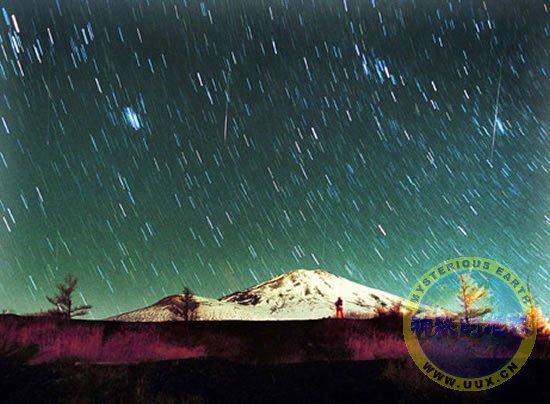Leonid Meteor Shower Peaks Saturday
Leonid meteors dot the sky over snow-capped Mount Fuji, Japan's highest mountain, in a time-lapse photo taken November 19, 2001.
The annual light show will peak this year with about a dozen meteors an hour at 11 p.m. EST on November 17.
Photograph by Itsuo Inouye/AP
Christine Dell'Amore
National Geographic News
November 16, 2007
The dazzling Leonid meteor shower will streak across the skies again on Saturday.
The annual light show, which occurs in mid-November, will return this year with a maximum of about a dozen meteors an hour at around 11 p.m. EST.
North American skywatchers will get an unusually clear view, as the moon will set early and leave a dark canvas for the illuminations to begin.
Past Leonid events have been particularly spectacular— from 1999 to 2002, the yearly showers neared the intensity of "meteor storms," when viewers spotted up to a thousand meteors an hour.
This year's meteor rates are expected to be much less showy, with an outburst lasting about one to two hours, according to forecasters at NASA's Leonid Multi-Instrument Aircraft Campaign.
"There will be pretty much normal shower activity, 20 per hour at most," said Bill Cooke, head of NASA's Meteoroid Environment Office at Marshall Space Flight Center in Huntsville, Alabama.
"We don't expect any more spectacular Leonid displays for over 20 years."
Comet Debris
The Leonids are remnants of the Tempel-Tuttle comet, which follows a 33-year orbit that extends as far as the planet Uranus.
The showers are visible when Earth travels through debris left behind by the comet. Those particles, which can be as small as a grain of sand, appear as meteors streaking across the sky.
(Get the basics on meteoroids.)
Each year, Earth makes its way through different trails of debris, sparking varied displays of brightness.
Leonid's meteors are the fastest, racing through the atmosphere at 44 miles a second (71 kilometers a second).
"They haul—they move considerably fast, since the meteor and Earth almost make a head-on collision," Cooke said.
The meteors also leave glowing trails that hang in the sky for a few seconds before dissipating.
Prime Viewing
Leonids are named for their location in the constellation Leo, a mythical lion figure. The arrangement of stars creates an outline of a lion's head and mane.
After midnight, when Leo climbs into the sky, is the best time for skywatchers to look for the meteors.
Fans can visit http://leonid.arc.nasa.gov/estimator.html for the most up-to-date advice on spotting the cosmic bodies.












